Getting drug molecules into the brain means crossing the defensive blood-brain barrier. Anthony King investigates how chemists are infiltrating the brain's fortress
Ordinary activities like exercising or eating can alter our blood composition fairly dramatically. Blood potassium may increase, for example, and there can be significant shifts in its lipid and amino acid content. Metabolites toxic to nerve cells can even enter the bloodstream.
The blood-brain barrier, thankfully, blocks flotsam or jetsam in our blood from traversing into our brains. This is crucial because neuron signalling in the brain relies on electrical signals and fine chemical signals, which require a precisely regulated microenvironment, and this can be easily disturbed by molecules coming in from the blood.
’You don’t want your communication centre disrupted by things that may be happening in the stomach, gut or other area of the body. You want to have it stable and working perfectly whether you are sleeping or being chased by a tiger,’ Lester Drewes of the University of Minnesota in Duluth, US, explains. The blood-brain barrier, or BBB, consists of the endothelial cells lining the blood vessels in the brain. These fortress cells are glued together very tightly and, in contrast to other organs and tissues, there are no chinks between them for blood-borne materials to leak into brain tissue.

This defence is a real headache for treating brain tumours and other neurological conditions. Drugs, treated as foreign molecules by the BBB, are unable to pass. In fact, over 95 per cent of drugs do not show useful activity in the brain and many show poor penetration of the BBB. A high proportion of large molecule drugs do not cross, which encompasses all the products of biotechnology: recombinant proteins, monoclonal antibodies and RNA interference drugs.
William Pardridge, director of the Blood-Brain Barrier Research Laboratory at the University of California Los Angeles, US, believes the drug development mission for Alzheimer’s disease and other brain disorders has suffered by focusing on central nervous system drug discovery while a blind eye was turned to drug delivery. He says that no large pharmaceutical company in the world today has a BBB drug-targeting programme.
Slippery customers
An early strategy for crossing the barrier was to make drugs more lipid soluble; this allowed them to penetrate the lipid-loving endothelial cells in the brain. Most drugs of abuse, such as alcohol, cocaine and heroin, are lipophilic. But there is a downside: ’If you make something lipophilic, it’ll penetrate every organ and cell in the body and so you must use large amounts. If it can have a bad side-effect on another organ or tissue, it will occur,’ says Drewes.
Some small drugs - such as L-DOPA used to treat Parkinson’s - can be ferried in on natural ’nutrient transport systems’, but this approach has complications in finding the right dosing regime, as patients’ transporters have differing efficiencies. Also, although lipid-soluble drugs may get into the brain endothelial cell membrane, they may get thrown out just as quickly by efflux transporters.
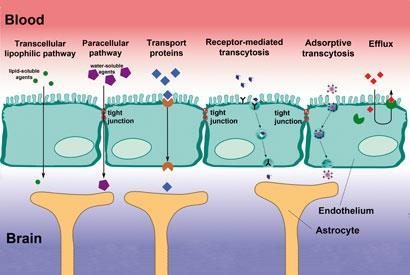
’The biology is really against drug delivery to the brain, so clever strategies are needed,’ says Joan Abbott, a neuroscientist at King’s College London, UK. ’In the past, big drug companies had simplified things by sticking to small molecules which had the right chemistry and avoided the efflux transporters.’ One important recent insight is that increased lipid-solubility is not necessarily better; for most drugs it is the ’free unbound’ concentration in the brain that is important, whereas lipophilic drugs tend to stick to other structures inside the brain, including lipid membranes. ’Company drug chemists are now taking this on board,’ Abbott adds.
However, these days companies realise they need much more intelligent drugs to make them more specific with fewer side effects. ’That’s why they are trying to explore novel chemistries, novel delivery vehicles and even techniques for briefly opening the BBB then closing it again after a drug has entered,’ says Abbott.
Temporary portals
Tumours that begin in the brain are among the most aggressive and lethal cancers, yet treatment options are limited by the BBB. Last summer, researchers in Taiwan reported successfully disrupting the barrier using focused ultrasound (see Chemistry World, September 2010, p24). Led by Kuo-Chen Wei of Chang Gung University, the group injected magnetic nanoparticles, coated with a chemotherapy drug, into rats. They used ultrasound to open up a small area of the BBB and a magnetic field to guide the particles to a precise location in the brain.1

Ultrasound could also help in conditions such as Alzheimer’s and Parkinson’s, says Kullervo Hynynen from the University of Toronto Medical School, Canada who has done similar work with ultrasound and microbubbles. The exact physical and biological mechanism of ultrasound is not known, he points out. ’We know that bubbles are expanding and contracting with the ultrasound wave, and some fast microscopy experiments have shown that the small blood vessels - at least in vitro - expand and contract with the bubble. Therefore the endothelial cells are stretched.’
Electron microscopy has supported this idea of physical stretching of the barrier cells, though some active vacuole transport across endothelial cells is also induced, notes Hynynen. The potential risk of any BBB disruption methods is that you let your guard down. Molecules will enter the brain during disruption, but this risk is small as only a defined area of the brain is exposed. The difficulties with ultrasound relate to the lack of knowledge about the mechanism by which it works, along with factors relating to safety, efficacy and timescale (such as how long the barrier is open).
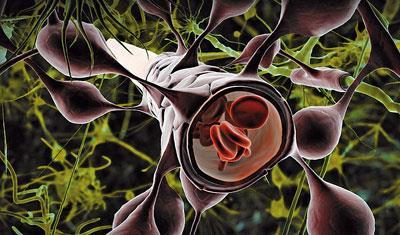
Another disruptive approach is to inject a hyperosmotic solution (one which has a higher solute concentration than the surrounding cells) into the carotid arteries to open the BBB for a time. This method has been championed by Edward Neuwelt of Oregon Health and Science University in Portland, US, for some years now. ’The fluid flowing through the blood vessels is hyperosmotic and so draws water out of the endothelial cells, causing them to shrink’, explains Drewes. ’This pulls apart the tight junctions, forming gaps and spaces. If you administer an antitumour drug to the blood stream, it can diffuse into the brain and into the tumour.’ The cells gradually swell back to their usual size, so the effect is transient.
While cancers that develop in the brain are relatively rare; 10 times as many people develop brain tumours from cancers that begin elsewhere in the body. The BBB stymies modern cancer therapies that work elsewhere in the body. US researchers recently gave the field a lift, however, using erectile dysfunction drugs. Julia Ljubimova of Cedars-Sinai Medical Centre in Los Angeles and her colleagues found that Viagra (sildenafil) and
Levitra (vardenafil), which inhibit an enzyme called phosphodiesterase 5 (PDE5), increased the permeability of the blood-brain barrier. Using a mouse model, they showed that these drugs can increase the amount of Herceptin, a large monoclonal antibody used to treat lung and breast cancers, crossing the BBB and increase its anti-tumour effect in the brain.2
Piggy-backing on the BBB
Beverly Davidson, a neurologist at the University of Iowa, US, has been seeking a therapy for children who suffer from lysosomal storage disease, caused by the absence of a particular brain enzyme . ’We know we can’t simply deliver the enzyme into the blood and have it access the brain, so we try to devise methods to overcome this problem,’ she explains. Her group took barrier endothelial cells and engineered them to produce the missing enzyme and secrete it into the brain itself.3’Essentially we’re turning the BBB into our friend as opposed to our enemy.’
The recombinant DNA that produces the enzyme was delivered into the endothelial cells using a viral vector that the researchers had modified to home in on the diseased brain endothelia. Davidson hopes that the new genetic material will remain in the endothelia for many years. ’We have no evidence that these cells are dividing at all, at least in rodents,’ she explains, so a single round of gene therapy could last for decades. The treatment reconstituted enzyme activity throughout the brain of a mouse model; the next step is to move to a large animal model of the disease.
Canadian company AngioChem has developed a different way to sneak therapies across the barrier - by harnessing its own transport receptors. These receptors, like the lipoprotein receptor related protein (LRP-1), normally allow essential substances like glucose, insulin and growth hormones to enter the brain. ’They are seeing what appears to be the first success on delivering something that will attack a tumour,’ says Drewes. ’There is some excitement about that and they are trying to develop it into a more general drug delivery system.’
Delivery vehicles and Trojan horses
Another area of real growth is in artificial constructs, or engineered delivery vehicles, says Abbott: ’Over the next 10 years I’m expecting lots of those.’ Nanoparticles and various polymers can be engineered to have the right features to bind drugs but also to recognise receptors on the brain endothelial cells so they get taken across the barrier. One advantage of polymers is you can tune them chemically, notes Martin Garnett of the Children’s Brain Tumour Research Centre at the University of Nottingham, UK, who has begun some work on polymer nanoparticles.
Ljubimova believes that nanomedicine will bring about a major leap forward for cancer treatment and improve the quality of life for patients by reducing the toxicity of treatments. ’There are lots of things in clinical trials, predicting big gains "in five to ten years time",’ she says. However, Abbott offers a word of caution concerning such drug vehicles. ’The difficulty is the same as with transporters in the BBB. Calculating how much of a drug gets into the brain via delivery vehicles is quite hard. Most of the evidence suggests the amount reaching the right target is quite small, so you have to go for really active agents.’

A Trojan horse method, which links therapeutic agents to molecules that normally transit the barrier, is championed by Pardridge. He has re-engineered glial-derived neurotrophic factor (GDNF) as a molecular Trojan horse. GDNF is a potent neurotrophin that can revive damaged nerves in animal models of Parkinson’s disease; it’s also a potential therapy for stroke and drug addiction, but it does not cross the BBB.
Using implanted drug reservoirs and ventricular catheters - both invasive procedures - researchers discovered that the GDNF they delivered was biologically active but lacked clinical efficacy. The problem was distribution; very precise location of catheters was needed, and this was not achieved in all clinical trials. Pardridge’s Trojan is a monoclonal antibody against the human insulin receptor, which can deliver GDNF across the BBB.4 In trials with Rhesus monkeys, he has seen no adverse events associated with administration of large doses of the antibody-GDNF fusion protein.
Breaking out of the lab
Abbott suggests that one reason progress on BBB drug delivery has been slow is a lack of funding and interest from industry. She explains that big pharma has largely withdrawn from aspects of brain chemistry and drug delivery because they’ve put a lot of money into programmes that have turned out not to be productive. They are now more cautious, more pessimistic, or are focusing on areas with greater chances of success. Some companies may even feel they are not competent to pursue brain targets where the BBB is a challenge. Its complex chemistry makes predictability more difficult.
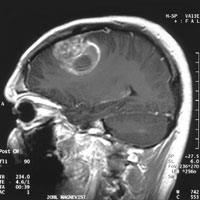
There are positive signs, though. In vitro cell culture models of the barrier - needed for drug permeability assays - have been improved over the last few years. Imaging techniques like positron emission tomography (PET) and magnetic resonance imaging (MRI) help show what the BBB is doing and which drugs get to the right targets in sufficient concentration.
This is critical, as researchers have come to realise that the barrier is not a static defensive structure. It’s an active, regulated and regulatory interface; it is altered at and around the site of injury after a stroke, for example. According to Neuwelt, brain tumours, epilepsy, Alzheimer’s disease and Parkinson’s disease are all associated with ’perturbations in the normal BBB that contribute to their pathology.’5
Information on the status of the barrier in a particular patient may be necessary to devise and refine appropriate therapies. Increasingly in, for example, post-traumatic stress injuries, it is being recognised that you need to know what the barrier is doing to adjust your treatment, says Abbott. You may need to adjust treatment over a period of months or weeks.
Garnett says pharmaceutical companies have, up until now, concentrated on small drug molecules rather than drug delivery systems, but he believes that this is now changing. Moreover, there is an active research community within universities and research institutes looking at ultrasound, Trojan fusion proteins, polymer constructs and other means of surmounting the barrier and getting therapy to where it is needed.
Abbott concludes with an upbeat assessment on the BBB and efforts to get therapies across it: ’There’s been lots of progress in the last five years. We see all sorts of things that are now possible - so in terms of basic understanding, I think things are looking really good. But it is probably true to say that much of the innovation is coming from small companies; some of these are partnering with or have been taken over by bigger companies. Traditional big pharma is still rather cautious in trying new ways of getting things into the brain, although this is changing.’
Anthony King is a freelance science writer based in Dublin, Ireland
References
1 H-L Liu et al, Proc. Natl. Acad. Sci. USA, 2010, 107, 15205 (DOI: 10.1073/pnas.1003388107)
2 J Hu et al, PLoS One, 2010, 5, e10108 (DOI: 10.1371/journal.pone.0010108)
3 Y H Chen, M Chang and B L Davidson, Nat. Med., 2009, 15, 1215 (DOI: 10.1038/nm.2025)
4 W M Pardridge and R J Boado, Pharm. Res., 2009, 26, (DOI: 10.1007/s11095-009-9939-6)
5 E A Neuwelt et al, Nat. Rev. Neurosci., 2011, 12, 169 (DOI: 10.1038/nrn2995)




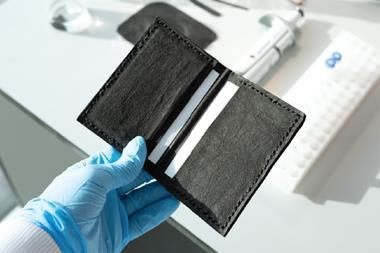
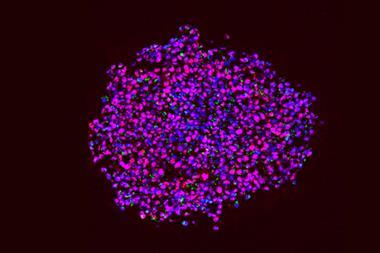

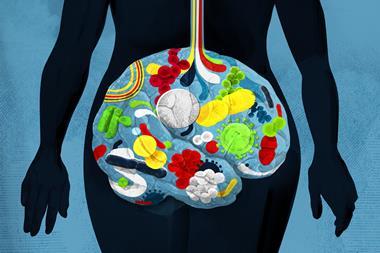
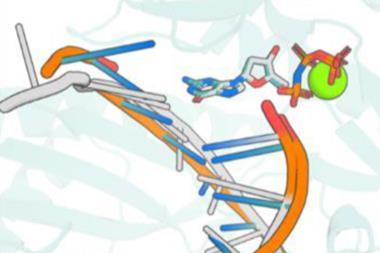




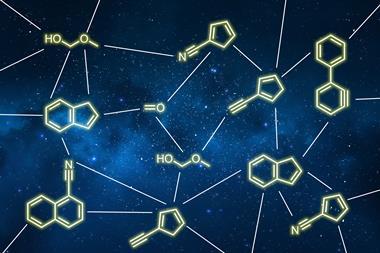

No comments yet